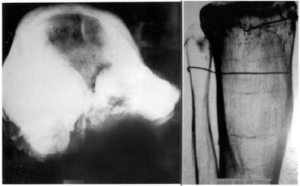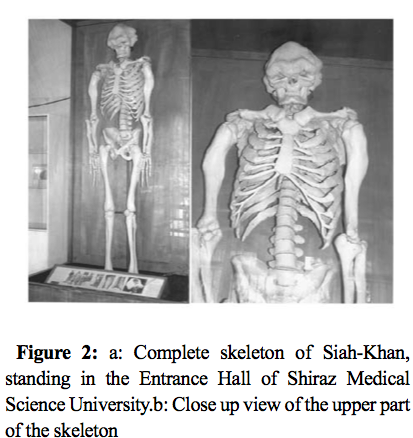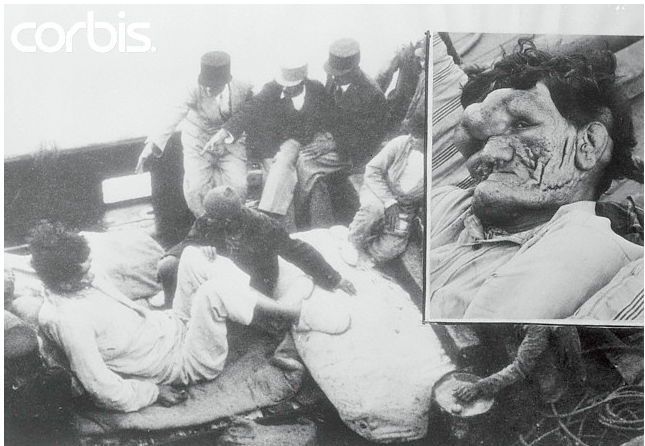I have talked about Siah Khan And Zech Devits before in the posts “The Development Of Gigantism Without Pituitary Abnormalities: Studying Zech Devits And Siah Khan, (Important!)” and “The Connection Between Matt McGrory, Siah Khan, Zech Devits, And The Tallest Filipino Leads To Proteus Syndrome And Much More (Important!)”
This post is to focus more on what could be the genetic mutation which lead to Siah Khan. His case is one of the most unique, and most interesting of all giants I have studied. The abnormalities found on his face makes him so unique that there has really only been 1 case of his type in all of documented medical history.
The main resource I have to use was the study “Cranio-Spondylo-Tubular Dysostosis A Unique Historic Iranian Giant” –
Note: I do have a copy of the full PDF of the study somewhere on this website.
Author(s): Mohammad Hassan Sheikholeslami, Yousef Shafeghati , Zabihollah Ghorban
MD – Tele-fax: +98(21)44 633 283
Article abstract:
Severe overgrowth and tallness is very rare in human beings. The most common cause is gigantism due to the excessive secretion of the growth hormone, especially, before the closure of long bones’ epiphyseal growth plates. There are other rare disorders that are categorized on overgrowth syndromes. Herein, we report an extremely rare, or even perhaps a unique, patient from Iran. The clinical and skeletal findings were very unusual, with extensive clavarial, tubular, vertebral, ribs, and scapular overgrowth and synostosis. Indeed, the results of these abnormalities made a monstrous giant with a very tall stature. This is a unique case, which was living during 1912-1940 in Shiraz. The report’s information and photos, kindly supplied by Prof. Sheikholeslami. We evaluated thoroughly the findings together. Now we think; this is a very unusual case of its type, perhaps a Craniotubular Dysostosis Syndrome. We searched medical and clinical genetics literature, but did not find any similar case, having been reported before. So, to our knowledge, this is a unique case in the history of world medicine. We suggest to call this entity; “Siah-Khan syndrome” (after the patient’s name), or “ Ghorban-Sheikholeslami-Shafeghati Syndrome” (in honour of Prof. Ghorban who was recently has died, or “ Cranio-Spondylo-Tubular Syndrome”.
The other main website to see what Khan was like is from a website that is almost all in Arabic (click HERE)
Analysis & Interpretation:
Sometimes the doctors or researchers who study these giants are too busy taking pictures, and trying to handle all the press and media from having such a patient that they barely ever do any science or analysis on why this Iranian giant ever even existed. The other title given for the study was “A Unique Historic Iranian Giant “Siah-Khan Syndrome”, Report of an extremely rare or perhaps a unique case in the world from Iran”. The paper first states that this guy was born in the early 20th century to a normal family (father and mother and siblings are all normal). His birth shows that he was average sized. His growth spurt started around the age of 6 and by the time he was 9 years old, he looked like a guy who was 20 years old. Siah Khan started to develop deformities on his skull, face, arms, and legs and young kids started to become very scared of him. Eventually the family managed to get in contact with a Professor Ghorban in 1922. Khan was subsequently put in the hospital for care. He stayed there until he was 28 years old, when he died from pneumonia and sepsis in 1940. After his death, the professor felt his body was too precious and unique so didn’t bury it but put it up for display, where it is supposed to be presently in the main entrance of some university called Shiraz Medical Science University.
The paper itself is only 5 pages long and says that Khan was 259 cms tall and 250 kgs. If the numbers are true, that means Khan was standing around 8 feet 6 inches tall! It is also written that Khan is supposed to be mentally below average with a huge sexual apetite and could not turn left or right, or even stand up from sitting down. There is clear bony projections on the person’s face.
They state….
Occipital bone growing backward.
– Frontal bone growth progressing to the forward and downward of the eyes as a thick wall limiting the field of vision just like a front porch.
– Large hands with long fingers.
– Large feet, very flat feet, bumping steppage.
– Great appetite as much as 3 to 4 people with good appetite.
– Looking like a strong, dry piece of thick wood and unable to move in different directions because of the fast growth of bones and early vertebral body fusion
The height of the skeleton is 259 cm; the lengths of the upper extremities were 117 cm, and the lower extremities 125 cm. The very severe overgrowth in calvarial bones, clavicles, scapulae, long tubular bones, ribs, and pelvic bones are apparent.
 I personally took the liberty to clip and put the picture in the article of Khan’s only 2 X-rays, of his skull and his lower limb bones. It is noted that his tibia and also fibula was rather enlarged and sort of porous.
I personally took the liberty to clip and put the picture in the article of Khan’s only 2 X-rays, of his skull and his lower limb bones. It is noted that his tibia and also fibula was rather enlarged and sort of porous.
The physicians are right that there can be many different causes and reasons for gigantism, which is supposed to be labeled as any person who is 3 or more standard deviations above what the average height of people in their main group should be. After listing through what could have cause the gigantism and bony overgrowth on face, the Iranian researchers seem to suggest that Siah Khan suffered from something called Craniodiaphyseal dysplasia. As they say it…
Craniodiaphyseal dysplasia (CDD) is a rare craniotubular remodelling disorder with hyperostosis and sclerosis of the skull and facial bones, along with hyperostosis and defective remodelling of the shaft of the tubular bones. The epiphyses and metaphyses are only mildly affected.
The other disorder which they sort of claim could be the cause is something called Craniometaphyseal dysplasia (CMD)
In Craniometaphyseal dysplasia (CMD), there is progressive facial dysmorphism with a broad osseous prominence of the nasal root extending across the zygoma. Autosomal dominant and autosomal recessive types of inheritance have been described. In general, recessive CMD is more severe than the dominant CMD
The thing which the scientists at that time, and which we as height increase researchers can only say is that Siah Khan suffered from a very sever form of CDD or CMD, and his case is very unique. There was little blood work and no genetic studies done on him, since he lived in the the early 20th century. If he was born in the 21st century, we probably would have been able to help him out much more and be better and figuring out what exactly caused his condition.




Pingback: A Theory That Epiphyseal Growth Plates Never Fuse For Certain People | Natural Height Growth
when I was reading your article i saw something wrong that i wanted you to know…
“The other main website to see what Khan was like is from a website that is almost all in Arabic (click HERE)”
there is a huge difference between arabic language and persian language…the website is persian not arabic…we use same alphabet but total different language…we can’t even understand each other…it’s a bad heritage of the time they attacked us…1300 years ago…